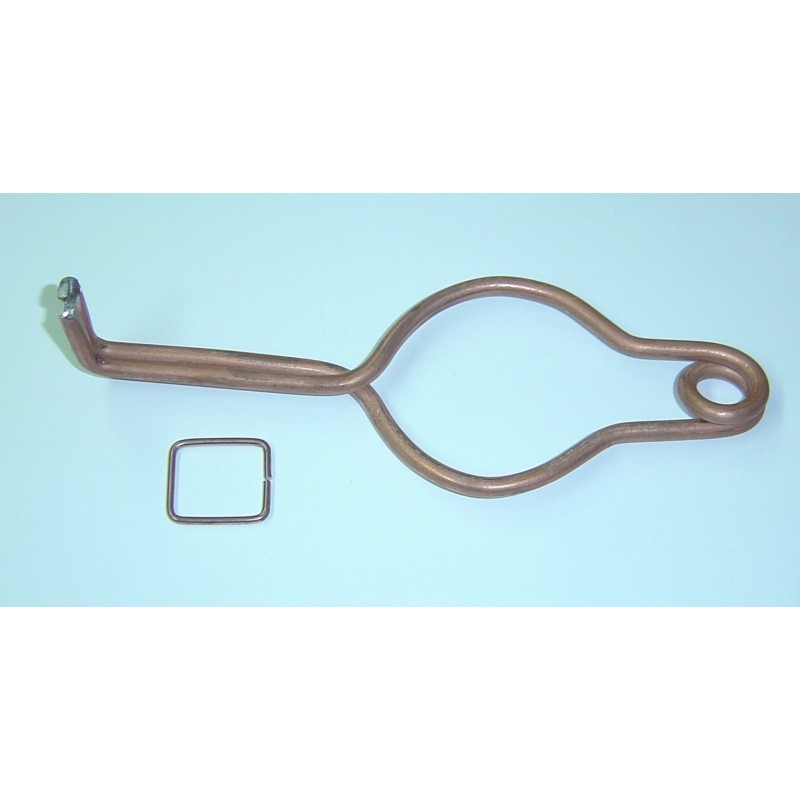-
Content Count
5,225 -
Joined
-
Last visited
-
Days Won
1
Content Type
Profiles
Forums
Gallery
Articles
Gun Dealer's and Fieldsports Shop's
Reloading Room
Blogs
Calendar
Store
Classifieds
Posts posted by Nicepix
-
-
LOL That's would be on its side if the trap had been set prongs up. The reason some of mine are caught with the scrapers across the line of the prongs will be down to them going over top of the prongs.
-
Are any of these unusual traps any better than the Talpex I wonder??
If the grounds right i will use talpex jd but not this time of year to much hassle .nicepix my dads neighbour in france ihas been a molecatcher all his life he,s now in his seventies and still at it, he always puts them on their side as i do most of the time each to their own they,ll catch either way. Can,t get my head round why you and mr muddy are catching them on their sides though...anyone else??
LOL You might be overlooking the obvious. How is the mole trapped - scrapers aligned with the prongs, up and down, or across them?
-
Apples and oranges Mr. Darcy.
I use Talpex when conditions suit, Flatpack tunnel taps when they will work best and the Putanges have their place. I couldn't imagine just having one type for all my trapping. I don't regard any as being better than the others.
-
 1
1
-
-
Mr. Muddy; Thank God I'm not the only one with bad experiences with Traplines. I gave them a real good try, but had too many foul captures to continue with them. Some were caught around the middle and one managed to crawl to the surface, trap still attached. Typical American; over complicated, over priced and over here.
Torchey, I usually set them on their back (prong up), trigger about 1" back from the jaws and narrowist way around. Mostly I use them in shallow runs under turf, third leg of a three way tunnel or when I can't fit a Duffus or Talpex in. I always peg them to prevent the trap moving when the mole comes into contact with it. I've got about forty and all but two are currently underground.
-
 1
1
-
-
Around half I reckon. No idea why, but I thought it might be down to the mole squeezing through the trap like they do in stony soil or areas with a lot of roots obstructing the tunnels. A lot of my jobs are in areas with lots of small stones in the soil.
I know that you've been using these for some time and rate them highly. I was a little sceptical at first but have now got a lot of confidence in them. I wouldn't use them 100% of the time like the local trappers do, and set them differently to how they do, but I wouldn't be without them. I'd rather have these than Traplines any day.
-
 1
1
-
-
Must be a French thing. Around half of mine have rotated 90 degrees so their scrapers are top and bottom when the trap shuts on them. Either way, they are well dead!
-
The video isn't representative of how it is done. The French pro's carry a large spade and a bucket containing the traps, pins to peg them down, a small narrow trowel or spoon like tool to rake out the holes and a setting tool. That's it. And you can carry a lot of these traps in a bucket. Some hang the traps off their belts with the triggers already in place.
I pin my traps down purely to stop any movement when the mole hits the trap. Usually the mole is caught sideways which to me suggests that they turn and squeeze through the prongs. I prefer to use them in shallow runs such as those visible under turf or under patios.
In turf I just cut a segment of turf out, clean the holes either side, slide the traps in, put small pieces of fence wire through the trap eyes to secure them, pop the turf back on and slip a small plastic flag into the turf to mark the site. Easy-Peasy.
-
Don't take too much notice of that lad's techniques. The pro's are a lot quicker, neater and less fussy. Also, he puts the trigger quite a bit further back than is conventional. Mine are set 1" (25mm) back from the jaws. That way the mole is trapped around the neck or shoulders.
-
 1
1
-
-
Just walked in the house from a few hours shooting feral pigeons and the trap from Mr Muddy is waiting on the door mat(Thank you). You would need a setting tool to set these traps they seem quite well made. Quick shower and i will take it round to see if we can make a few .I think some type of jig has to be made to fit the machine first but everything seems to be ok to go.
I have printed a photo of the setting tool of the interweb so you never know i could get him to make this as well???.
Iwm
If you need a setting tool send me a PM with your address and I'll post one over to you. I use a different type to the basic ones, more like circlip pliers, as they are easier to use. But I have a few of the lever type spare.
-
These traps have been used for decades over here and most French pro's use nothing else. The way they do it is very different to how you and I trap moles. For a start their spades are more like shovels and they don't bother probing relying on taking out a huge solid clod from between the molehills. The clod is kept intact and Putanges are placed in the exposed holes either side of the excavation so that they are almost totally inside the tunnel. Next a long orange rod of around 2mm wire is put into the eyes of each trap and the clod is lowered back into place leaving the orange wires sticking up through the surface.
How do they check the traps? Usually a dog is used. Typically a dachshund or similar breed indicates whether there is a mole in the traps. If they haven't got a dog it means lifting the clod and checking the traps.
As well as the Putange for moles there are similar traps designed for other pests such as rats, lerots (garden dormice) and the rat taupier, a strange animal that burrows like a mole, but eats plants and bulbs.
Only recently has the garden centre chain Gamme Vert started selling the type of traps we would use. I can get Talpex off the shelf at €9.99 each. That's £7.42 in your coinage. Their tunnel traps are cheap Chinky crap though. When I go round on my jobs I see all sorts of traps that have been used by customers. Some are antiques, most are crap, but I've seen enough redundant Beagle traps to build a small wall.
-
 1
1
-
-
As I said in my first post they are not all the same. Some are made from thinner and / or weaker round bar than others and rust far more quickly. Some of the ones I've bought could be set by hand, but the ones I now use would be impossible to set by hand. They occasionally cross over and it needs a trowel or screwdriver to lever them back in position. I can't even set them using the lever tool. It needs the pliers type tool.
There are different types of design too. The "Putange Main" is designed to be set by hand, but are much weaker and more bulky.......

The best way to attach the trigger is via a piece of twine as the others have shown. If you try to use metal you will run into two possible problems. Firstly the prongs might cut the metal if the trap fires when setting. Secondly, the weight of a chain or wire could drag on the bottom of the tunnel and cause the trigger to displace during the setting process. I had some with thin bath plug type chains that were a pig to set so I replaced them with braid fishing line.
These things have worked for decades so why mess about with a successful design?
-
 1
1
-
-
Good news. But, I'd advise against using any metal for the connection between trigger and trap unless you can fix it central on a short link. I've had a few different types of Putange including one with a long metal chain link and it was useless. The problem is that if the trap misfires as in when setting the prongs coming together can cut the chain or link. It happened several times and believe me, finding the trigger that has fired itself up a mole tunnel isn't easy. I also tried electrical tie wraps with the same result. I now use 80lb braid fishing line but builder's twine as recommended earlier is just as good.
I'm from Barnsley so the Yorkshire connection is going strong!
-
Just as an aside, you can use the Putange mole traps to catch other pests. I've had field mice, lerots (garden dormice), rats and this unexpected capture from a mole tunnel in them..........
I also put them in any rat holes I find around the customer's garden to good effect. I would imagine some of you creative pesties could make good use of them as they can be set very discretely.
-
 2
2
-
-
Been out all day setting, digging down through the first inch of frozen turf with the knife was a bitch after the first hour or so, wasn't sure the moles were really going to be that active, but I walked past a trap I'd set ten minutes before and there was one in there.
As for covering, all I do is lift a frozen hill a little way from the trap site, place loose soil on the trap and then stick one of the frozen lids "hills" over the hole, easy job.
That would work OK if there was no thaw. Get a bit of sunshine on the frozen tump and it might collapse onto the trap and then re-freeze overnight. If it works for you then fine, but I prefer to play safe and I'm only doing garden jobs at the minute so there is no problem carrying enough bits of insulation with me.
-
It has been -7C overnight and barely above freezing in the day out here. I've been insulating my tunnel traps with pieces of bubble wrap or pieces cut from those car windscreen sun shields to stop the soil covering freezing up and preventing the trapping loops from activating. Its OK suggesting finding some soft soil to cover the traps if there is any to find. But in some areas where the soil is claggy and mostly clay I have to grub round under bushes or nick soil from compost heaps if I want to cover the traps without the heavy stuff. Even then, at -5C or less the soil will freeze if there is any amount of moisture in it. The bubble wrap or car sun screen is soft enough to give when the trap goes off but keeps the frost off.
-
I've been watching this thread for a few days. I am based in France and was on here previously under a different name.
Just be aware that the Putange traps are like any other type in that the quality differs dependent on the manufacturer. I have bought and used quite a few over the last two years and some are frankly useless. The spring loses its strength and they rust quite quickly. Rust means that the triggers don't slide freely and can prevent the the traps from operating. It is a pain to keep having to rub them down with an abrasive paper or file. I got some from a local hardware shop that are if anything overly strong and do not rust. However, the usual (non-pro) customers complained about them being hard to set and the shop stopped doing them. Bah!
If you are serious about making them I would suggest that you forget trying to make them as cheap as here in France which is currently €3.95 (just over three quid) for a pair including triggers and a setting tool, and instead make a more durable product out of tempered stainless wire.
As others have said; these are very useful traps and in my opinion knock Traplines into a cocked hat. You can use them under patios, in stony soil, slipped down a molehill shaft like those Dutch traps (I caught one yesterday in that manner) and are great for those surface runs where the mole has just pushed up the turf. If you are getting traps nicked or want to prevent tampering these are just the job. Cut out the clod, lift it out intact, place the traps, replace the clod and mark with spray paint or a bit of plastic pushed into the turf. The downside is that they are more fiddly to set in deeper tunnels. Best thing is that they are light and compact to carry and are as cheap as chips.
-
 1
1
-





Mole Traps In The Frost
in Snaring, Trapping & Pest Control
Posted
Yep. In the case of a trap set prongs up the mole sometimes turns sideways, scrapers up and down in line with the prongs and is caught that way. If you set the prongs horizontal the mole doesn't need to turn as its scrapers fit between the prongs more easily. We are achieving the same results.